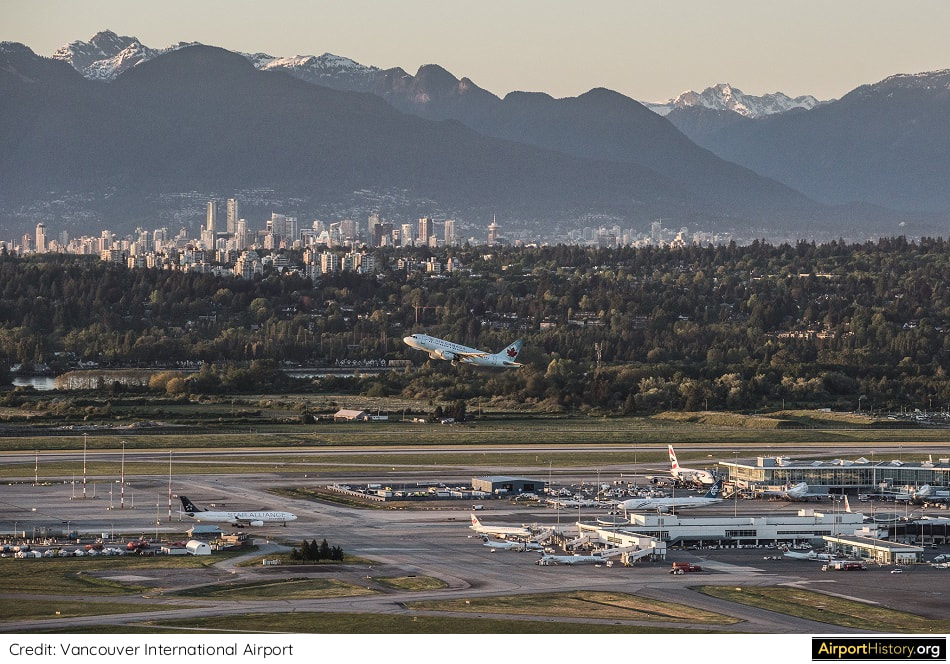|
Did you know that Vancouver International Airport was almost built at a completely different location? As "YVR" celebrates its 90th birthday this month, guest author Solomon Wong tells us the brief story of Vancouver's planned main airport at Spanish Banks.
'NO FIT FIELD TO FLY ON'
The current Vancouver International Airport opened on Sea Island on July 22, 1931. Prior to this location of YVR, it was 2 km east on Lulu Island (Richmond) next to the Lansdowne race track (now a shopping centre). In 1929, Charles Lindbergh most infamously refused to fly to Vancouver because there was “no fit field to land on,” prompting a search for a new site. Ultimately, Sea Island became the choice, where YVR is located to this day. Many have written about the birth of YVR on its current site, but few people know about the alternate reality where the nearby Spanish Banks could have been the site for Vancouver’s airport.
Image credit: Google Earth
SEA TO SKY
Spanish Banks is a beach area immediately north of the University of British Columbia and represents the quintessential “sea-to-sky” experience of Vancouver: beachfront, water, snowcapped mountains and forests (see image below).
VISION FROM AN AVIATION PIONEER
The visionary behind the proposal submitted in 1928 to the City of Vancouver was Donald Roderick MacLaren, one of the foremost Canadian aviation pioneers. Before he would become the first employee of Trans Canada Airlines, the predecessor of Air Canada, MacLaren founded Pacific Airways Limited at Vancouver in 1924, carrying out fishery patrols and aerial surveys for the Government of Canada. Pacific Airways also started commercial air services between Seattle’s South Lake Union, Victoria, Vancouver and other coastal communities.
The plan at Spanish Banks was a two-phase airport and seaplane base, complete with hangars, taxi stands, customs facilities and fencing lit at night. Phasing for a future airship field would be in place to the west of the site, with three runways of roughly 2,000 feet (600 meters) in length each.
The concept to build airports on beach sides close to downtown was actually quite similar to airports like New York's LaGuardia and John F. Kennedy that would be developed over the next two decades.
AN ECLECTIC MIX OF AVIATION AND LEISURE
The brochure and plan was unique for a number of recreational amenities immediately adjacent to the airport. A 20,000-person stadium, beaches, children’s bathing channel, swimming pool, winter gardens and a planned park all evoked a destination for visitors in addition to aviation activities. Perhaps air shows were contemplated to have stadium seating for plane spotting? Cost-wise, the total project was estimated at CAD 3.1 million in 1928 dollars, roughly CAD 50 million today (approximately USD 40 million). The proposal was actually approved by the Municipality of Point Grey: On May 8, 1928, The Vancouver Sun newspaper reported its councilors voted five to three to approve a proposal by Vancouver Terminals Ltd. “to convert the residential area facing Spanish Banks into a highly industrialized area with terminal railway facilities, airport and wharves.
However, the proposal, including the airport plan did not materialize. That same year, the Sea Island site was selected by Vancouver Mayor William H. Malkin and the Vancouver Board of Trade.
A good decision in hindsight: in order to accommodate modern day traffic levels, the Spanish Bank Airport would have to be expanded using expensive land reclamation, occupying a big part of the Burrard Inlet.
The current Sea Island site was farther from the city, but land was abundant, cheaper, and also adjacent to a waterway suitable for seaplanes. Vancouver is one of the few airports in the world which still has room to add terminals and runways, ensuring its future role as Canada's Pacific Gateway.
Happy Sea Island Birthday to YVR!
Solomon Wong was born and raised in Vancouver and is an enthusiast for never-built ideas. An urban planner by training, he heads a consulting firm InterVISTAS working on market, strategy, planning and digital transformation projects worldwide.
Would you like to guest-author an article about your favorite airport, built or unbuilt? Drop us a line!
More airport articles: Click here
Want more stunning airport photos & stories?
Sign up to our newsletter below to know when new content goes online!
1 Comment
Gregory Melle
10/6/2022 22:23:51
Interesting to note that the proposed "highly industrialized area" is now the home of the most expensive homes on Canada's west coast.
Reply
Your comment will be posted after it is approved.
Leave a Reply. |
With a title inspired by the setting of the iconic 70s film "Airport", this blog is the ultimate destination for airport history fans.
Categories
All
About me
Marnix (Max) Groot Founder of AirportHistory.org. Max is an airport development expert and historian. |










 RSS Feed
RSS Feed